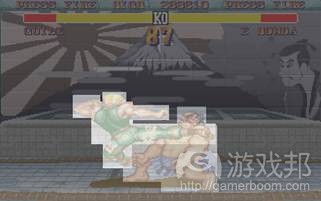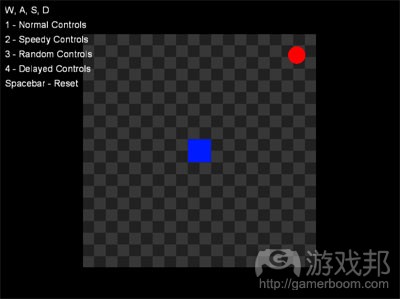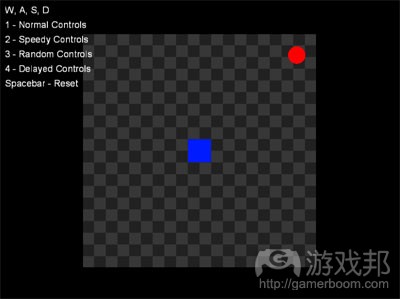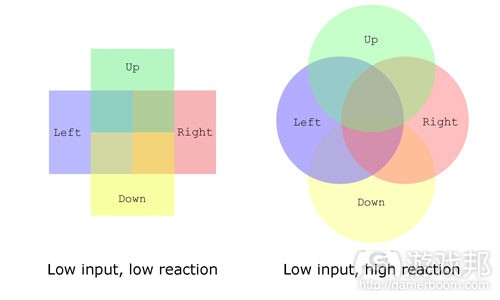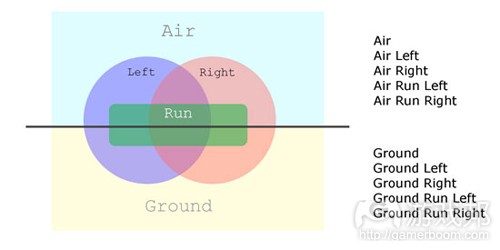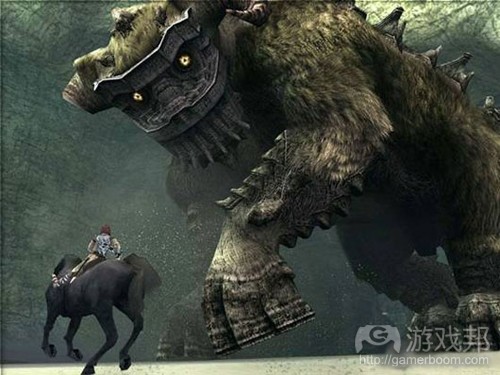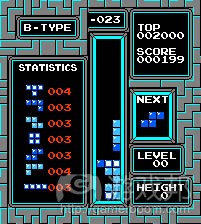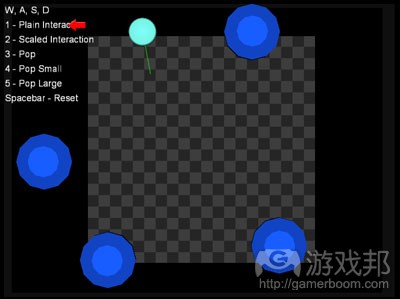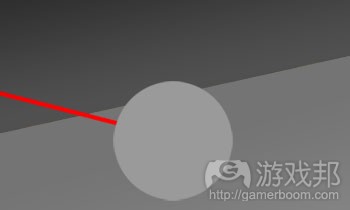根据动画原则阐述创造虚拟感的7大原则
作者:Steve Swink
游戏的“感觉”是什么?所有玩家都知道它且能轻易地唤起这种控制虚拟角色的感觉。正是这种感觉,让你在希望马里奥移动更快一点时,身子左摇右摆、疯狂地按你的控制器。这种感觉使你能熟练地控制某些在你身体之外的东西,使之成为你的意志和直觉的延伸。这种“虚拟感”是电子游戏的精华所在,是人机互动中最吸引人、最有趣的属性。
控制感是复杂的直觉:为了产生这种强大、迷人的感觉,无论是在电脑中还是在玩家的意识中,都有太多事情要发生。那么,如何利用这种感觉来制作更好的游戏?
本文探索了主导这种控制游戏中某物的“感觉”的深层原理。就好像根据“动画原则”制作优秀的动画,我们可以根据虚拟感的原则制作出引人入胜的玩法。作为参考,动画原则如下:
1、挤压和拉伸:当物品运动时,扭曲它可以体现它的硬度和形态。
2、时间:调整动作发生的间隔以突出物品的重量和大小,或角色的个性。
3、预期:动作的准备。
4、表演:清楚明确地展示想法。
5、跟随动作和重叠动作:动作的终止和建立它与下一个动作的关系。
6、连续动作和关键动作:这是形成移动的两种不同方法。
7、慢入和慢出:形成流畅的动作的中间帧的间隔。
8、弧形:自然移动动作的虚拟路径。
9、夸张:通过夸张化设计和动作突出核心想法。
10、次要动作:由一个动作产生的另一个动作。
11、吸引力:创造一种观众喜欢看的设计或动作。
动画原则好就好在它们是不可辩驳的美学标准。遵守这些原则的动画比那些不遵守的动画更好。但有意思的是,美学的主观性似乎使普遍的美学标准变成不可能。我们无法解释品味这种东西。尽管动画原则适用于所有动画,因为它们从属于由潜意识加工的美学属性。你无法说清为什么你在有挤压有拉伸的动画和没挤压没拉伸的动画中,你更喜欢前者。你只是觉得就是喜欢。
电子游戏也有一套类似的统摄性美学原则。设计师如果能掌握这些根本原则,就能多一种理解虚拟感和创造虚拟感的工具了。这样不仅节省了游戏制作时间,而且减少重制工作量,使设计师可以把更多心思放在解决其他不具普遍性的问题上。如果我们不用浪费宝贵的生产时间从无到有发明某种工具,那么我们就有更多时间去创造其他独特而美丽的东西了。
什么是虚拟感?
当开车时,你对小车的位置会非常敏感,这是因为你有一种操作、控制乃至精通小车的感觉。这是每一个学会开车的人都有的能力——将本体感觉延伸到身体之外以控制身外之物的能力。在学习和最终掌握这种动觉转换的过程中,人会获得极大的愉悦感。抽象地说,当你重新映射你的神经通路时,你就是在供养你的大脑,大脑就回馈你愉悦感。所以,人们经常试图掌握新的、越来越困难的映射:运动、攀岩、杂技、独轮车,等等。许多人还在电子游戏中找到这种愉悦感,因为电子游戏不仅保留了现实运动的精华,而且避免了现实运动的约束和危险。你可以改变小车的转弯半径,但你不能改变重力。这种控制体验来源于人造的动觉。这就是游戏的“感觉”,一种让你在玩《Rad Racer》时在座位上左摇右摆的东西。虽然我们已经开发出其他配件如控制器摇杆来支持和强化这种虚拟感,但它的实质自《太空大战》和《桌球》诞生以来就没有改变过。
当形容操作游戏的感觉时,玩家通常会用物理类比,比如说操作“很轻”、“紧张”、“顺畅”、“迟钝”或“不准”等。这些感觉通常伴随着非常强烈的本能反应。通常还会产生爱或恨的情绪,往往还是被过分强调的。史上最佳游戏、史上最差操作、史上最丑画面。这些就是明确的美学判断,这些判断暗示了游戏涉及某些固有的原则。
为了确定这些原则,我们必须描述一下传统卡通动画,从短片《兔巴哥》到长篇电影《白雪公主》,再到电子游戏中的虚拟感。按照定义,传统动画其实就是一系列从头到尾线性播放的图片。相反的,游戏中的虚拟感主要是由玩家输入驱动的。如果没有输入,那么就没有活动。
这个介于动画和虚拟感的描述看似不相干、但很重要,因为电子游戏与传统动画存在大量交叉。许多游戏图层就是把线性动画的物品和角色放在他们的静止的背景上。
例如,在游戏《街头霸王2》中,有一个由许多不同动画组成的精细的子画面,当玩家按下某个按键或执行某个输入时,它就会被回放。尽管在这个“佯装出拳”系统之下是非常基础的虚拟感。操纵杆的活动直接映射到屏幕上的角色动作上,而那个动作事实上是极其简单的。参考下图(图1),想象一下《街头霸王》的角色被替换成灰盒的样子,这样你就理解什么是纯反应性的,以及什么是动画的。
(虽然角色的形状取决于玩家触发的动作,但潜层活动是相当简单的。)
另一点要记住的是,虽然虚拟感是好游戏的强大基础,但它与其他游戏设计的关注点是有所分离的。比如说,在调整游戏的抽象数值以达到平衡时,开发者是不考虑虚拟感的。虚拟感主要发生在最底层的交互作用上,也就是你每时每刻都在经历的本能体验而不是有意识的体验。也许这就是为什么玩家极难说清自己为什么喜欢或不喜欢某款游戏的感觉。
虚拟感的7条原则
我在这里提出虚拟感的7条原则,但愿能帮助游戏设计师理解人机互动,以改进“本能感觉”。当设计师实践这些原则时,其实就是有意识改进玩家无意识的体验。
1、可预测的结果:通过正确理解玩家的输入并提供连贯的、可预测的结果,使玩家产生一种掌握和控制的感觉。
2、新颖:每一次输入触发的反应都有微小的差异,使玩家觉得各个反应都是新鲜而有趣的。
3、牵引:通过奖励玩家的实验,鼓励玩家掌握、控制和学习某种活动。
4、入门容易,精通困难:使机制直观但深刻;也就是玩家理解它只需要几分钟时间,但要掌握它则需要非常长的时间。
5、情境:通过规则和机制所运作的空间背景,赋予机制以意义。
6、冲击感和辨识度:通过与物体之间的交互作用和物体与环境之间的互动作用,体现物体的重量和大小。
7、吸引人的反应:无论情境或输入是什么,游戏都产生的吸引人的反应。
无论是什么类型的游戏,无论是2D还是#D游戏,都适用以上原则。只要存在虚拟感,这些原则就能帮助改进它。
至于如何使用这7条原则,具体见下文。
1、可预测的结果:通过正确理解玩家的输入并提供连贯的、可预测的结果,使玩家产生一种掌握和控制的感觉。
这是虚拟感的基础。如果顺时针旋转你的小车的方向盘,会使小车随机地从左边转到右边,那么你将无法控制它。没有预测输入产生的结果的能力,也就不可能产生控制或掌握的感觉,虚拟感就更加无从说起。尽管这是一个非常直观、容易理解的概念,但许多设计师因为某些原因破坏了虚拟感,比如把输入映射到太难处理的结果上,导致映射本身不自然或不直观,又比如给玩家太多可能性,导致一致的结果也显得随机。
创造虚拟感的一个误区是,认为虚拟感所依托的游戏总是正确的。我们通常以为,因为游戏不存在技术性问题——它每一次都能准确接收和处理输入,即它接收输入和反馈有意义结果的方式与玩家意图一致。据Will Wright观察,游戏设计是一项半技术半心理学的工作。就游戏而言,即使给定输入的结果保持内部一致性,如果移动得太快或玩家难以理解,那么移动就是不可预测和不可控制的。在Cube Movement 1测试中,用正常操作接触红点很容易,但加速操作就困难多了,甚至使人感到困惑。随机控制变化使玩家不可能准确地预测给定输入的结果,因此玩家会觉得困难沮丧。
另一个影响可预测性的设计是映射。映射是指游戏中介于操作、动作和结果之间的关系。根据输入设备和游戏的展示法,你可以预料给定动作产生的结果。自然映射利用这些预期,使玩家能够立即理解玩法。例如,使用Cube Movement 1中的正常操作,四个键是空间对应的:按上键是使方块向上移动,按左键是向左移动,以此类推。另一个实现自然映射的方法是借助文化标准,这在游戏中通常是指“类型惯例”。使用键盘上的W、A、S和D键分别对应对象的向上、左、下和右方向移动——这是电子游戏界普遍接受的文化标准。
除非你为了追求某些实验性目标,所以有意创造一种反直觉的感觉如Wario Ware公司的《Mega Microgames》中的反向操作的高尔夫球迷你游戏、《生化危机4》中的笨拙、压抑的感觉,否则你就应该遵守空间对应法和文化标准,因为它们能够创造出更容易学习和记忆的映射关系。
最后,避免给玩家提供太多状态,那样会让玩家觉得不知所措。虚拟感的“状态”是指在游戏过程中的映射的变化。举个简单的例子,在《超级马里奥兄弟》中,当马里奥接触地面时,他可以向左和右快速移动。而在半空中时,他的移动就没有那么敏感了。也就是说,当你按下方向盘的向左或右键时,直到他回到地面才会改变方向。状态变化是不错的设计,因为它往往能促进玩家的表现和即兴发挥、增加反应的敏感性(见原则的第四条:入门容易,精通困难)。只要各个状态容易识别且转化明显,那么可预测性就不会被降低。缺陷就是有可能让玩家对太多的状态感到不知所措。当按下某个键不再产生相同的结果时,结果就不再是可预测的了,控制感也进而消失。例如,无经验的玩家很容易被状态可能性太多困扰。例如,如果玩家以前从来没有玩过《Tony Hawk》,他们就会摆弄几下控制器就放弃,并得出结论“我不喜欢滑板游戏。”那款游戏的状态太多,使玩家觉得输入是随机的、结果是不可预测的。另外,状态改变太难感知,并且滑雪者移动的速度太快,进一步打击了潜在的玩家。玩家如果在头几分钟内无法被游戏吸引,他们就会选择放弃。
状态的另一个问题是模糊性。如果没有清楚的机制来显示系统的当前状态,那么输入模式就可能产生看似随机的结果。如果玩家同时乱按几个键,或拇指意外地碰到第二个键,那么结果对他们来说就确实是随机的了。再者,游戏是按毫秒来接收输入的,所以它知道第一个输入是什么。然而,对于玩家,结果看起来就是不一致。引用Mick West的一段话:
“在《超级马里奥64》中,先按下A键跳跃再按R1就是地面重击。而先按下R1再按A就是后空翻。同时按下两键就可能产生地面重击、后空翻或正常的跳跃,似乎是随机的—-所以玩家就无法控制了。玩家可能反复同时按下这两个键,但永远想不出如何正确地控制这三种动作。
在Cube Movement 1中,同时按下1、2和3键,你就会看到看似相同的输入产生基本上随机的结果。
可预测性也意味着推断——从游戏一开始的前几分钟,玩家可以推断出整个游戏的结构图景。这是一件好事,能吸引玩家,使玩家克服对游戏世界的陌生感、鼓励他们学习新机制。在《超级马里奥兄弟》中,我知道如果我掉进洞里,我就会损失一条命。只需要掉过一次洞就能推断出这个结果,所以我在接下来的游戏中会避开洞。这就点出了一个重要差别:某物是可复制的并不等于它就是可预测的。做某事A总是产生结果B并不意味着你可以借此推断出结果D,你还是得做某事C。一个可预测的结果揭示的可能性应该像你已经尝试过的行为一样明显。
作为游戏设计师,我们必须记住,我们捕获玩家的时间非常有限。如果他们在游戏的头几分钟不能找到方向、获得成就感,那么我们就失去这些玩家了。最低层次的反馈循环,他们遇到的第一样东西,就是虚拟感,即时反馈的操作。如果玩家不能在直觉水平上对游戏产生好感,不能沉浸于可预测的结果中,那么他们就会离开这款游戏。一定程度上,虚拟感就是游戏的其他所有体验的守门人。
2、新颖:相同的输入产生各种不同的结果。
虽然虚拟感必须以可预测的结果作基础,但也应该有新意。也就是,相同的输入(或玩家认为是相同的输入)应该产生稍微不同的结果,以保持玩家的兴趣,避免“审美疲劳”和增加虚拟感的整体吸引力。虽然可预测性和新意看似矛盾,但二者是可以和谐共存的。当二者和谐共存时,强大的虚拟感就产生了。
新意的大敌之一是线性动画。即使是在《Jak and Daxter: the Precursory Legacy 》这种线性动画的品质异常地高且有许多动画变体的游戏中,玩家也很容易就看出Jak每次出拳都是相同的。问题是,一旦用过头,即使是高品质的内容也会让人觉得无聊。看Jak出拳一万次,肯定比第一次看要无聊得多。为了保持玩家的兴趣,必须让玩家在玩了几个小时后仍然觉得新鲜有趣。甚至重复性动作也应该每一次出现时都让玩家觉得有新鲜感。
许多游戏试图通过添加大量额外内容来解决这个问题,也就是让玩家经历一系列挑战性越来越高、有所变化的关卡,这些关卡为虚拟感提供新鲜有趣的情境,从而避免玩家觉得乏味。另一个解决办法是在游戏过程中引入更多机制——补充和调整虚拟感。例如,《Castlevania: Dawn of Sorrow》在增加新虚拟感方面做得非常好,即引入不同的“魂”和武器以增加新的虚拟感,每一种都使给基本活动添加不同的感觉或新状态(如腾空二连跳)。还有一种解决办法是使用确定性总体物理系统,它通过禁止玩家重复相同的输入来保持虚拟感新鲜。在确定性物理中,从技术上说,相同的输入会产生相同的结果。游戏如《Bridge Builde和《Ski Stunt Simulator》可以准确地记录玩家的输入,精确到毫秒,所以将这个输入返回给系统,总是产生相同的结果。对于无法准确地理解复杂、微秒的模拟的玩家,就会觉得这些游戏确实存在新意。虽然在《Ski Stunt Simulator》中,玩家可能会不断得到相同的结果——例如,跳过沟谷再后空翻过一间小木屋,但永远不会出现两次相同的滑行。这是因为虽然主导模拟的参数每一次反应都是相同的,但玩家不可能感知最微小的差异。游戏比玩家的感知力更敏感,这是感知力影响虚拟感的众多方式中的一种。因为我们的感知力会根据现实世界敏感地做出调整,所以物体发生交互作用和移动时,我们会下意识地估计某事会发生。我们的预期之一是,两次运动不可能完全相同。这是现实的本质:混乱和不精确。没有人可以两次做出完全一样的出拳动作,或两次掷标枪或铁饼完全一样。所以如果我们看到相同的活动以相同的方式一次又一次地发生,没有任何微妙地变化,那么我们就会觉得虚假。
最后,保持虚拟感的新意和趣味的一个好办法是,允许即兴表演和表现(详见最后一条)。如果玩家觉得自己有不同的状态,如果那些状态以许多不同的、有趣的方式重叠,玩游戏就会变成一种自我表达的形式。
3、牵引:通过奖励玩家的实验,鼓励玩家掌握、控制和学习某种活动。
在许多游戏中,玩家的大部分时间是费在经历失败上的,特别是在游戏的前几分钟,因为这时候玩家的游戏行为是纯实验性的。玩家在争取掌握新的机制、新的动觉转化的这几分钟里,必然会遇到困难。而这前几分钟也是他们唯一能给我们的,所以我们必须给他们提供能让他们感到立即成功的工具,以便他们产生继续玩下去的动力(牵引力)。
牵引力出现在玩家在游戏中首次获得成功后感到自己有所掌握的时候。在那个找到方向和觉得安全的时刻,玩家理解了游戏的结构、知道游戏的挑战所在。如果玩家的水平正好与那些挑战相匹配,那么他们就会觉得有趣并继续玩。如果他们始终没有获得牵引力,那么他们很快就会放弃游戏。牵引力就是给玩家良好的反馈—-立即、清楚和实用的反馈。
没有立即反馈,就没有虚拟感。如果转动小车的方向盘意味着三十秒后小车才能行驶,那么就不存在掌握或精通了。只有在立即的结果中,才能产生掌握的感觉和转换动觉的能力。在游戏中也是一样的,虚拟感的产生有赖于电脑的即时处理性能。回合制游戏中不存在虚拟感。例如,在Cube Movement 1中使用延时操作时,显然不存在虚拟感,如果反馈不即时的话。
还是在Cube Movement 1中,同时按下1、2和3键。你会发现你的行动的结果仍然是随机的。现在按下Enter键,你应该看到一个对应系统当前状态的箭头。同时按下1、2和3键,仍然产生随机结果,但现在游戏给了你行动后的清晰反馈,虽然没有正确反映你的意图。一个比较好的解决办法可能是把所有模糊的输入默认为正常操作设置,也就是最容易操作的设置。但最重要的是,保持反馈的清楚明确:只要你知道你当前所处的状态,你就不会被受到模糊结果的负面影响。
最后,反馈必须实用,意味着它必须准确地把游戏状态告诉玩家。如果你失败了,你知道为什么吗?失败状态是否帮助你改进后来的行动?
在《马里奥赛车DS》中,为了成功你必须使用“red sparks”,它发生在进入“power slide”状态之后。“power slide”状态会改变驾驶输入的映射,使玩家得以重新适应赛车而不必直接转向。进入“power slide”状态后,操作的反应性被大大抑制了,但整体转弯半径更加准确。这意味着为了通过急转弯,玩家必须进入“power slide”状态,这就导致有效地使用“power slide”状态成为游戏中最重要的技能。如果你成功地进入“power slide”状态,就会触发烟雾颗粒效果和轮胎摩擦发出尖锐叫声,告诉你状态改变了。另外,因为驾驶操作的反应性降低了,所以玩家迅速敲击左和右键有可能不会明显地改变赛车的轨道。如果玩家连续迅速地按下左键和右键,就会出现一个明蓝色的火花特效,伴随着令人喜悦的声音:明确、即时和实用的反馈告诉玩家另一个重要的状态出现了。重复快速敲击左键和右键,蓝色火花就会变成红色的。这时,退出“power slide”状态可以获得加速效果,伴随着的是完全不同的颗粒特效和声音特效。如果你不能靠“power slide”执行执行急转弯,那么你就不可能正确地完成转弯。如果你没有看到轮胎上冒出烟雾以及听到尖锐的声音,那么你就知道你还没进“power slide”状态入。如果你在“power slide”状态下迅速按下左和右键,却没有看到火花,那么你就知道你没有做对。如果你退出“power slide”状态而火花是蓝色的,那么你就知道你没有获得加速效果。
《马里奥赛车》是一个向玩家传达多个微妙状态发生变化的好例子。许多游戏在这方面做得不好,严重影响了玩家对游戏的感觉。有趣的是,糟糕的虚拟感也是可能被掌握的,但很难让玩家理解游戏状态。只要有足够的确定性,玩家就有可能学习所有虚拟感。许多玩家为自己能够克服这种障碍感到骄傲。也许是因为游戏有很好的内容或有特别吸引人的多人模式。无论是出于什么原因而学习虚拟,也无论精通之后能产生什么美妙的体验,让玩家得不到自己的行为的重要反馈,都是不合理的。
如果你总是给玩家良好的反馈,那么你的玩家将获得一种连贯的、可量化的进步。游戏最吸引人的地方之一是让玩家获得可量化的进步感,这通常模式化为得分、升级或其他数值性的指标。与日常生活相比,这种进步感是受人欢迎的,因为现实生活中极少存在这种可量化的进步。
4、入门容易,精通困难:使机制直观但深刻;也就是玩家理解它只需要几分钟时间,但要掌握它则需要非常长的时间。
优秀的游戏是简单的,几分钟内就能学会,但要精通可能得花上一辈子。容易学习,游戏才能吸引所有水平层次的玩家。难以掌握,游戏才能把玩家长久地留住,刺激他们进步。在“入门容易,精通困难”的游戏中,虚拟感就是这种现象的反映。玩家首先必须精通游戏,这是之后所有交互活动的基础。游戏的整体体验就是游戏让玩家产生的虚拟感。虚拟感的不同方面可能突显为目标、关卡、场景、道具、武器等等,但核心都是一样的,这个核心存在于游戏的开端,就是必须在两分钟或更少的时间内提供牵引力的虚拟感。
入门容易意味着虚拟感容易学习。这有不同的情况:虚拟感可能非常复杂,因为有很多不同的输入和状态,但仍然比较容易学习,因为它由自然映射开始,输入产生的结果是可预测的,而且用即时反馈抵销状态过多的负面影响。相反地,非常简单的虚拟感可能会因为缺少清晰的反馈或映射太模糊而让人迷惑或难以学习。是否容易上手不是由虚拟感的复杂性决定的。
精通困难意味着完全掌握虚拟感需要非常长的时间,如果可能掌握的话。例如,在原版《Pong》游戏中,操作是简单的,但怎么“掌握”?唯一的办法就是通过比赛。在这种情况下,精通的感觉存在于玩家的心中。如果他们觉得还有进步的空间,他们就会继续玩下去。玩家对于精通的理解可能是,不断打败对手、通关游戏、成为服务器上得分最高的人(如《CS》)、完成设计师安排的所有任务(如在《超级马里奥64》中获得所有的120颗星星)……玩家完成各种目标以显示自己的精通程度,而游戏设计师最擅长的就是提供匹配和超过这些程度的挑战(或让玩家创造自己的挑战)。但是,提供各种挑战还不够。游戏想要长盛不衰,另一个必要条件是,虚拟感有足够的敏感性来满足技能层参差不齐的玩家。
一个技能层是指玩家在进入下一个技能层以前必须掌握的技能和知识。例如,在游戏《Ski Stunt Simulator》中,第一个技能层是学习如何让滑雪者向前和向后转弯、做各种姿势以及向前和向后保持重心。下一步,玩家要学习如何在闪避和站立之间迅速转换,即跳跃。当你学会跳跃并且能轻易地重复时,你就可以学习在跳跃时前倾或后倾、前空翻等。再接着,你学习如何后空翻,等等。《Ski Stunt Simulator》的技能层有很多,所以“重玩性”接近无限。
制作一款具有大量技能层的游戏的方法之一是,谐调输入敏感性和反应敏感性之间的关系。在Cube Movement 2中,正常操作的输入敏感性和反应敏感性都比较低。输入敏感性低是因为只有四个按钮,每个按钮只有两种状态,即开或关。反应敏感性低是因为游戏对各个按钮的反应只有两种状态,全速移动或不移动。这不是非常好的虚拟感,太死板太生硬了。以原版《塞尔达传说》为例,在某些情况下,这种生硬的虚拟感是理想的,因为它给玩家更多思考机会,而不是依赖本能反应来玩游戏。但在《吃豆人》中,所有旋转和多余的移动方向都为了简化游戏而被删除了。然而,移除这些后,并没有产生非常强大的虚拟感。
现在试一下切换到“低输入,高反应”的操作。输入敏感性仍然一样——四个只有开和关两种状态的键盘按键,但现在这个机制似乎更流畅和有序了。这是因为反应敏感性更高了。当按下按键时,不再只是开始和停止移动这两种状态,而是移动速度逐渐提高到全速,而且停止输入后要过一会儿才会停止移动。这样的操作就比较微妙了,精通的难度就比较大了。与正常操作相比,更像原版《超级马里奥兄弟》。游戏用更长更流畅的状态响应简单的的按键输入。因为现在各个状态要花一会儿时间才能消失(向前移动会先变慢再完全停止,然后开始另一个动作),游戏就有许多有趣的叠加状态,使玩家体验到的运动感更强。
现在再尝试一下“高输入,低反应”操作,这是由鼠标驱动的。使用这种组合,输入设备(鼠标)的敏感性会非常高,但游戏的反应几乎为零。方块基本上就是一个大光标。这是非常自然的映射;光标在屏幕上的位置对应鼠标在桌子上的位置,所以你很容易掌握方向和操作。另外,这样使用鼠标是电脑操作的基本技能,所以这已经成为全球文化标准,进而导致我们觉得这种映射很自然。尽管相当无聊,对吧?因为这种映射在多年的电脑使用中已经被我们内化了,所以没什么可学习的,也没什么转换需要掌握。因此,鼠标移动就不会有什么虚拟感;快、爽、没有任何的的质量感或存在感。
相反地,“高输入,高反应”操作有一些可取之处。这种操作有非常有趣的动感,且要求一定程度的精通。拍打方块让它击中红点和实验放缓方块和反向移动或做八字形模式,让人感觉不错。甚至具有高输入敏感性和低反应敏感性(游戏邦注:如将鼠标移动直接映射到3D空间的FPS)的游戏,也需要一些反应性来缓和这种爽急的输入。
另一种在虚拟感中获得大量敏感性的方法是快速状态切换。正如之前所说的,玩家习惯于忍受游戏中的映射变化。只有良好的反馈告诉玩家状态变化了,那么就无所谓在游戏过程中改变操作的意义。这么做的好处是,反应敏感性大大增加(尽管增加得没有使对象从只有开和关两种移动状态变成逐渐加速或减速那么明显)。在《超级马里奥兄弟》中,表面上有三种操作:左移、右移和跳跃。但进一步观察可知,有许多不同的状态发生重叠,且以不同的交互方式让玩家觉得反应是灵敏的。
马里奥脱离地面时,他向左向右移动的敏感性大大降低:一个不同的状态。这是一个通过状态切换增加敏感性的简单例子。当马里奥腾空时,一种状态其实对应了两种不同的动作(取决于当时的情境)。而输入敏感性是一样的,玩家现在在游戏中有两套完全不同的动作,且事实上,这两种稍有不同的虚拟感交织在一起,达到了整体大于部分之和的效果。
另一种状态切换是把某种输入当作另一种的加强版,从而创造出新的反应类型。当马里奥在地面上时,按下B键,他会移动得更快,导致他进入另一种状态——奔跑。这似乎只适用在地面上活动的马里奥,但其实也作用于空中状态:跳跃前的移动速度决定了他能跳得多高。通过映射相同的输入产生不同的结果,事实上为玩家提供了更多可能性,也就是创造了一种比静态映射具有更多技能层的映射。
最后,时间和空间中都有可能触发状态切换。在游戏中,最常见的时间状态切换例子是连击:在某个时间段而不是另一个时间段内进行一系列按键输入会产生不同的结果。这种状态切换形式不是依靠某种同时输入的组合,而是历时输入序列。尽管结果是相同的:更大的敏感性和更多技能层。相同的事情也可以发生在空间中。我要引用的例子是只有单键输入的《Strange Attractors》。按下按键就是打开或关闭“the attractors”——一种把玩家的飞船拉向它们或推离它们的重力穴。每一个重力穴的拉力是多少,取决于飞船离它有多近。这个简单的系统,通过大量反应敏感性,使得甚至单独的的按键也能产生强大的虚拟感。
5、情境:通过规则和机制所运作的空间情境,赋予机制以意义。
在《超级马里奥63》中,有许多可能的移动。使用状态强化和状态切换,可以让马里奥三级跳、长跳、墙跳或后空翻等。现在想象一下马里奥站在空白的场景中,周围没有任何物品。如果马里奥没有可发生交互作用的对象,那么他有这些技能就毫无意义了。没有墙,就没有墙跳。这说明情境在虚拟感创造中的重要作用:使动作有意义。情境主要以三种方式影响虚拟感:间隔、感知和即兴发挥。
间隔是指游戏环境中对象之间的距离。对于任何虚拟感,总是存在一个感觉最好的空间范围。例如,在赛车游戏中,道路上通常有障碍物。障碍物的数量和它们之间的距离对虚拟感有很大影响。如果障碍物间距过大,玩家太少遇到它们,就会难以估计自己的技能水平,进而虚拟感也大打折扣。就像处于空白场景的马里奥,赛车游戏中的赛车必须有一个情境使它的旋转半径有意义。在Cube Movement 3中,操作接近于赛车游戏;S和F键对应旋转而不是向左和向右移动。选择“Context Empty”选项,会发现没有什么可产生交互作用,所以虚拟感基本上也不存在。
相反地,如果障碍间隔太小,总是干扰玩家,玩家就会觉得应接不暇、沮丧泄气,甚至觉得游戏已经超出自己的能力范围。我们可以在Cube Movement 3的“context full”操作中找到对应的例子。在DEMO中我们可以看到有许多距离接近的物体,对操作干扰非常大,结果当然是令人觉得挫败。将前进速度比物品的数量及其间隔,我们可以获得每秒遇到物品的粗略比率。如果这个比率太高,那么玩家就会觉得无法控制;如果太低,玩家就会觉得无聊。
另一个影响厌烦/沮丧交换比率的因素是感知。如果玩家可以提前5秒或10秒看到他们在道路将遇到的东西,那么操作就容易了。如果直到玩家几乎不够时间反应时才看到物品,他就会觉得操作太困难。如果摄像机放大或呈角度,使玩家不能提前看到物品,那么物品的间隔就没有意义了;即使道路上确实存在若干障碍物,如果玩家看到它们后没有足够的反应时间,玩家也不能有效地避开它们。回到Cube Movement 3,使用“zoomed”导致操作变得极其困难,因为玩家看到物品时几乎没有时间做出反应。但注意,速度感增加了,因为摄像机距离物品更接近了,所以移动显得更快了。相反地,使用“Angled”导致绕开障碍变得容易;然而,在这个设置下,速度感是很弱的。因此,与反应或输入敏感性一样,玩家感知与虚拟感的产生大有关系。
玩家感知还利用期待促进虚拟感,而这些期待是产生于对物理现实和其他媒体如电影的体验。回到赛车的例子,速度是相对的。玩家判断他们的赛车的移动速度的主要办法是观察静态物体移出的相对速度。以游戏《Burnout: Revenge》为例,如果物体消失得非常快,玩家的感觉就是速度非常快。如果物体消失得非常慢,或者如果场景中没有足够的物体,那么就不存在速度感了。在
Cube Movement 3中,“Slow”和“Fast”选项的实际移动速度是相同的。然而,在“Fast”版本中,地面上的小贴图成为移动的参照物,使人产生速度很快的印象。速度感存在于所有虚拟感中,无论是《马里奥》还是《Burnout》,都主要依赖空间情境和比例。如果移过的物体比被控制的物体大很多,就像Cube Movement 3的“Slow”版本中的地面,我们会觉得物品移动得非常慢。所以显然,像“Fast”版本一样改变比例关系,又会使人觉得运动更快。
玩家感知也受表现的严重影响。在《Shadow of the Colossus》中,巨人移动得非常慢,而且他们的脚掌落地时会引起“镜头抖动”,扬起一路尘土。这种庞大又迟钝的石头巨人的形象非常逼真、令人信服。如果他们移动得更快,或得移动时没有那些额外的效果来表现他们体积庞大的特点,那么这种形象就不存在了。这是因为物品的相对比例使玩家产生一种对这种庞然大物应该怎么移动的期待心理。庞然大物就应该有庞然大物的样子,小东西就应该有小东西的样子。从最庞大的岩石到最渺小的尘土,如果要移除它们,必须非常谨慎。
情境在任何游戏中都是很重要的。甚至是对于简单的游戏如《俄罗斯方块》,Alexei Pajitnov也要决定游戏区域应该10个单位宽、20个单位高。如果游戏区域是20单位的3倍宽,那么《俄罗斯方块》就会变成一款非常难的游戏。
6、冲击感和辨识度:通过与物体之间的交互作用和物体与环境之间的互动作用,体现物体的重量和大小。
好的虚拟感会让玩家强烈地感觉到物品的质量和重量。在游戏中观察物品的交互作用,只需要短短的时间,玩家就可以通过物品的相对质量和重量以及光影效果理解游戏世界中的物理法则。这个理解成为一种独立存在于游戏世界的自我参照的“感觉”——玩家不必测试所有可能性,就能非常清楚地知道任何行为可能产生的结果。这种潜意识地理解掌控着游戏世界中的一切交互作用的深层法则的感觉,构成虚拟感的一大部分。这种感觉是很实用的,因为它意味着物品都能以某种方式(可预测的结果)产生作用,且它是另一种形式的良好反馈:它有助于玩家准确地预测某个行为产生的结果。另外,当物品不能产生正确的交互作用时,它打破沉浸感——也就是Csikszentmihalyi所谓的“流状态”。当一个物品围绕着另一个物品,或当你射击某物时它却没有反应地消失了,你会想“咦,游戏是不是出错了”,这样流状态就被破坏了。把玩家猛地拉出流状态太多次,玩家就会放弃游戏。所以,好的虚拟感的另一个基石是,所有物品之间的交互作用是清楚的、一致的、令人满意的。
我们对于物理现实的作用方式的理解来源于观察物品的交互作用。如果你打翻一叠书,它们会以某种方式倒塌在地上。如果你朝墙壁扔网球,它会以不同但一样复杂的方式反弹回来。大量小小的、潜意识处理的变量会影响网球的反弹效果,如撞到哪里、停止前反弹和旋转多久。我们可以把网球游戏玩得很好,充分说明了人类有能力观察、处理和适应即时物理世界的动态。正如Chris Crawford在《游戏设计理论》中所说的,没有其他动物会打篮球。这正是使游戏交互作用中的辨识度难以达到令人满意的程度的原因:人类能在认知水平上,敏锐地、下意识地预测物体的作用方式。
解决这个问题的办法之一是,简化游戏的表现法。如果角色看起来就像照片那样逼真,那么玩家当然会期望角色与物品之间的互动应该完美地模仿现实生活。如果角色是风格化的或简化的,那么如果它们的交互作用也是简化的,就不会让玩家的期待落空。在许多游戏中,物品的表现法和虚拟感之间似乎存在一场永恒的斗争。看起来真实的物品如果交互得不好,玩家期待和游戏现实 之间就会产生巨大的落差。物品交互作用不应该成为表现法的障碍或约束。相反地,这应该是创造吸引人的虚拟感的强大的工具。
为了让物品交互作用有效地向玩家传达关于物品质量和数量以及交互本质的信息,你应该记住:你是在假装。目标只是为了让玩家心中产生一种质量、重量和力量的感觉。这不同于物品“确实”遵守物理学的方式或准确模拟。这更像亚里士多德的物理理论,他的物理学相比于现代物理学似乎有些奇怪和可笑,但却比后者更符合日常生活的经验。物品必须看起来像真的,这使得假装变得更容易。
有效地伪造物品交互作用的方法是观察人们如何感知物品。在动作中用采用夸张手法可以使观众觉得游戏动更可信。当用线条抽象出物品挤压和延展的动态时,虽然看来怪异而不自然,但做成动画却更容易为人所理解:
类似地,通过夸张游戏中物品之间的交互作用,我们可以更有效地表现物理属性。例如,在《马里奥赛车DS》中,当赛车撞到墙或其他赛车时,它就会像有弹性似地缩起来,但前提是这个冲撞要达到一定速度。另外,如果大赛车撞到小赛车,大赛车不只是撞到小赛车,还会以夸张的冲力把后者撞飞。在Cube Movement 4中,在“plain”设置下的物体交互作用是非常基础的。切换到“scale”设置后,物体的交互作用会更加夸张。注意,夸张后的交互作用更令人满意。良好的虚拟感就是这样处理物体的交互作用的,也就是,不只是体现交互作用的差异,而且突出其最重要的特征。
另一个有助于体现物体交互作用的是颗粒效果。在《马里奥赛车DS》中,赛车相撞的一瞬间会迅速产生大量颗粒,以此进一步突出赛车间的交互作用。如果赛车撞到障碍,不仅会产生颗粒效果,赛车还会被夸张的冲击力弹飞。对比切换到“No Pop”选项和切换到“Pop”选项,你会发现,有没有这种简单的颗粒效果对交互作用的生动性影响很大。即使在现实世界的物体碰撞中,产生颗粒喷射是很令人不可思议的现象(游戏邦注:如在《灵魂能力》中的金属摩擦产生火花),玩家也能正确地理解游戏。只要物体相撞时,物品的速度、质量和重量是合适的,那么玩家就能体会到冲击感。
到什么程度才叫作“合适”?例如,把Cube Movement 4切换到“pop small”选项,星星颗粒是一样的,但爆发的速度非常小,所以冲击感就不是那么理想了。相反地,切换到“pop large”选项,会让人觉得反应太过激烈,摇摆的圆形碎片就像高速旋转的叶片,一碰到金属就溅出火花。
最后,当表现物体交互作用时,最好能借鉴一下电影中的手法,特别是摄像技巧。一个经典的手法是,当发生大碰撞或爆炸时,摄像镜头也要跟着颤抖。在这方面,二战主题的游戏把这个手法运用得最深入,不仅模拟视线模糊,还有子弹壳剥落和枪声四起,这些都可以从电影如《拯救大兵瑞恩》和《红色警戒线》里找到样本。但除了战争题材,镜头摇晃几乎适用于所有类型的游戏,例如,平台游戏和格斗游戏也频繁地使用它来突出冲击感。
7、吸引人的反应:无论情境或输入是什么,游戏都产生的吸引人的反应。
当完全移除情境时,虚拟感应该仍然是吸引人的、有趣的、引人注目的。重点是,把意义与吸引力分离。在虚拟感中,情境的重要性体现在创造意义、为比例、速度和重量提供参考点,但它与纯粹的吸引力是分离的。在完全空白的空间中,如果游戏仍然是有趣的,那么虚拟感就有吸引力。回到Cube Movement 2,所有机制都是相当朴素的(唯一的情境就是不能碰撞的红点),但“高输入,高反应”的测试更有吸引力了。这是因为它的动作比其他三种更加复杂、流畅和有序。像Shalin Shodhan的《On a Rainy Day》和Kyle Gabler的《Big Vine》、《Attack of the Killer Swarm》和《Gravity Head》,都是奇妙的、有序的吸引力的虚拟感的好例子。
附加效果和动画也可以增加吸引力。在《Jak and Daxter》中,动画给原本非常乏味的虚拟感增加了不少吸引力。用于动画Jak的大部分技术来自传统动画——挤压和拉伸等。注意一下动画对虚拟感的感知的作用。把动画层剥离时,你会发现Jak的活动是相当简单的,但加上动画后看起来却是有序的、复杂的、迷人的。在《新超级马里奥兄弟》中也有类似的效果:如果马里奥只是一个方块,那么虚拟感就没那么吸引人了。然而,马里奥的奔跑速度渐渐增加到渐渐下降的循环、奔跑时突然转向时扬起尘土的颗粒效果,使(已经很棒的)朴素的虚拟感更加吸引人。
吸引力的另一部分是确保无论玩家给系统的输入是什么,结果总是吸引人的。对于像坠毁和失败状态,这一点尤其重要。一个比较好的做法是,让失败状态更加多样化和有趣,因为这是玩家花时间最多的地方。例如,在《Ski Stunt Simulator》中,滑雪者撞到其他东西让玩家觉得非常有趣,因为它只是一个玩偶加上模拟的关节和四肢,撞击滑雪者产生令人愉快的又有序的结果。它不只是一个循环播放的预制动画。他会撞到头、滚下山涧或挂在悬崖边上。在这种极限运动的意外中,看到他撞击和身体扭曲是非常吸引人的。玩家会产生非常直觉的兴奋反应,这对学习和掌握玩法都是非常有意义的。因为失败状态太有趣了,使玩家更容易接受和继续学习。如果你尝试了许多次仍然不成功,那么你会出于玩笑而故意让滑雪者到处乱撞。类似地,在旁边看别人玩的人通常会被《Ski Stunt Simulator》的逼真的效果特别是当滑雪者坠落,所吸引而去玩游戏。
所有权的重要性
本文上述讨论的所有原则的根本目标都是创造一种控制感和精通感,使它超越情境和平台,成为自我表达的强大工具。这种感觉创造了一种强大的所有权的感觉,当玩家能够以有诺曼底的方式在游戏中表达自我时,他就会感受到这种所有权的存在。游戏根据玩家的输入创造的任何人为效果成为一种重要的商品,借着游戏和玩家在其中取得的成就,玩家可以清楚地意识到认同感。玩家开始为自己的成就感到骄傲,开始产生与他人分享的渴望。比如《虚拟人生》系列,这款游戏以玩家对获数字物品和剧情的所有权为卖点,狂销上百万份。
良好的虚拟感对所有权感觉具有显著的促进作用。这发生在玩家已经完全掌握游戏机制和精通游戏中的绝大部挑战的情况下。在那时,玩家基本上打败游戏了。在游戏行业,这通常被叫作“重玩性”,这种属性与收益大有关系。确实,这个现象与所有权有关:如果玩家觉得自己对游戏有所投入,那么他就会继续玩下去。如果他们继续玩下去,他们就会开始宣传它。一旦精通,他们的虚拟感就会产生足够的允许即兴发挥的敏感性,通常促使自我表达的独特形式发生。
即兴发挥在游戏中是指一种不需要提前思考,立即就创造新的和有趣的动作组合,从而以流畅、有组织的方式适应游戏的环境。这是一种非常令人愉悦的、爽快的体验。当你的能力与你所面临的挑战相匹配时,你就进入流状态。为了产生这种即兴发挥,机制不仅必须拥有高度敏感性(介于输入和反应之间),还要能非常灵活地处理它与它的环境中的物体的交互作用。
有些游戏,如《Tony Hawk’s Underground》,通过多种可使用丰富的道具的状态和情境使玩家产生所有权的感觉。玩家可以用任何状态来经历场景,以许多不同的方式使用各种道具。道具之间的过渡非常平顺,这就进一步促进玩家的即兴发挥,因为玩家很容易在任意两个不同类型的道具之间切换。所以,任何两次战斗必然是不一样的,因为你会根据情况以不同的方式使用不同的道具。你即兴发挥时,对道具使用的判断是非常迅速的。在最高水平的操作中,这甚至表现得更加明显,因为玩家要搜索和执行一长串使用道具动作。他们寻找具有美感的状态而不是高分状态,他们会把最吸引人的部分录制成视频,分享到网上。对于这些玩家,因为所有道具在任何状态或相对位置中都有非常高的使用率,所以使《Tony Hawk’s Underground》成为解释性舞蹈的一种形式。
其他游戏,如《Ski Stunt Simulator》,通过极高的输入敏感性使玩家产生所有权的感觉。例如,滑雪板与地面的角度即使只有一点点差异,也会产生完全不同的着陆动作。因为游戏中有一套关于物体交互作用的整体法则——如果滑雪板与地面角度达到某个值或滑雪者的头部撞到地面,就会发生坠毁事件——玩家的即兴发挥和表达空间很大。例如,当滑雪者腾空将要触发坠毁事件时,滑雪者可以伸出滑雪杆防止自己撞到地面。这个技能不是事先确定的,相反地,是重组了几个简单的法则后产生的结果(如,你可以让滑雪者举起手臂,坠毁事件只在头撞地面时才会发生)。
最后,当游戏中有多个玩家时,表现就是交流沟通,这就产生了一种强大的新社交体验。例如在《战地2》中,如果你潜行到某人身边,给他一刀子,他的状态就从活变成死。在那种情境下,捅死一名敌对玩家只是玩游戏,让被偷袭成功的玩家感到有点儿不痛快。然而,如果当这名玩家死亡,你还继续捅尸体,那么这个行为的意义就完全不同了。这是对死亡玩家的直接侮辱和贬低,因为后者必须从自己的角色的角度看着他的尸体被一次又一次地捅,直到他可以重刷。
举一个个人的例子:有一次,我非常幸运地潜到一名资深玩家旁边。趁着他转身,我爬上他身后的梯子。当我爬到梯子顶端,我拿出刀子准备来个一击必杀。让我惊讶的是,他突然又转身了,正好看到他身后的敌人我。还好我还是在他拿枪打我以前把他放倒了。他在地上狂抽搐。通过网络,我可以知道此时他握鼠标的手一定在疯狂抽搐。
结论
所有游戏的目标都是提供娱乐的、精彩的流状态和社交体验,这些是看电影和书籍达不到的。吸引人的虚拟感让玩家产生挑战、精通和控制的感觉以及美妙的、独特于其他任何媒体的动觉体验,成为上述体验的重要基础。游戏设计师,必须理解什么能促进这些体验的产生以及需要什么工具和技术。我希望我在本文中提出的虚拟感的七条原则可以成为这种工具。
原文发表于2006年7月26日,所涉事件及数据以当时为准。(本文为游戏邦/gamerboom.com编译,拒绝任何不保留版权的转载,如需转载请联系:游戏邦)
Principles of Virtual Sensation
by sswink
What is the “feel” of a game? Every gamer knows it and can easily recall the sensation, the kinesthetic feeling, of controlling some virtual avatar or agent. It’s what causes you to lean left and right as you play, swinging your controller wildly as you try to get Mario to move just a little faster. It’s the feeling of masterfully controlling some object outside your body, making it an extension of your will and instinct. This “virtual sensation” is in many ways the essence of videogames, one of the most compelling, captivating, and interesting emergent properties of human-computer interaction.
The sensation of control is a complex and multifaceted phenomenon: so many things have to happen, both in the computer and in the player’s mind, for this powerful, compelling feeling to occur. How, then, can it be mastered and used as a tool to create better games?
This article explores the underlying principles that govern the “feel” of controlling something in a game. Just as the “Principles of Animation” guide good animation, these principles of virtual sensation are intended to guide good-feeling gameplay. For reference, the Principles of Animation are:
1.Squash and Stretch – Defining the rigidity & mass of an object by distorting its shape during an action.
2.Timing – Spacing actions to define the weight & size of objects & the personality of characters.
3.Anticipation – The preparation for an action.
4.Staging – Presenting an idea so that it is unmistakably clear.
5.Follow Through & Overlapping Action – The termination of an action & establishing its relationship to the next action.
6.Straight Ahead Action & Pose-To-Pose Action – The two contrasting approaches to the creation of movement.
7.Slow In and Out – The spacing of in-between frames to achieve subtlety of timing & movements.
8.Arcs – The visual path of action for natural movement.
9.Exaggeration – Accentuating the essence of an idea via the design & the action.
10.Secondary Action – The Action of an object resulting from another action.
11.Appeal – Creating a design or an action that the audience enjoys watching.
The Principles of Animation are fascinating because they are non-negotiable aesthetic standards. An animation that adheres to the Principles of Animation will be better than one that doesn’t. This is interesting because the subjective nature of aesthetics would seem to make a universal aesthetic standard impossible. There’s no accounting for taste, the saying goes. The Principles of Animation are applicable to all animation, though, because they pertain to aesthetic properties that are processed subconsciously. You can’t tell why you like an animation that has squash and stretch and why you dislike one that doesn’t. You just feel it.
The medium of videogames has a similar set of governing aesthetic principles. Identifying these underlying principles adds another tool to the designer’s toolbox, allowing a clearer understanding of virtual sensation and how to create it. This will save time in game production, reducing the iterative workload and allowing designers to focus on solving the interesting problems unique to their specific game. If we’re not wasting valuable production time reinventing the wheel, we have more time to create something unique and beautiful.
What is Virtual Sensation?
Driving a car, you have a very strong sense of the position of that car, the feel of steering and controlling it, of mastery. This is the ability that every person who’s ever learned to drive a car has: the ability to extend precise control over something outside your body. There is a great amount of pleasure in the learning and eventual mastery of such a motion translation. Very abstractly, when you remap your neural pathways, you are feeding your brain, and it rewards you with pleasure. So much so that people often seek out new and increasingly complicated mappings to master: sports, rock climbing, juggling, off-road mountain unicycling, and so on. Many people also find this pleasure in video games, where it is both distilled to its essence and free of the constraints and dangers of more physical activities. You can change the turning radius of a car, but you can’t change gravity. This experience of control is derived from an artificial kinesthesia. This is the “feel” of the game, the thing that makes your mom lean left and right in her seat as she tries to play Rad Racer. While accessories have evolved to enhance and support this virtual sensation – controller shake, for example – its essence has been the same since the creation of Spacewar and oscilloscope table tennis.
When describing the control of a game, players often use a physical analogy; the control is “floaty,” “twitchy,” “smooth,” “slow,” or “loose.” Accompanying these descriptors are very powerful “gut” reactions. Terms like love and hate are often invoked, with superlative emphasis. Best game ever, worst controls ever, worst camera ever. These are plainly aesthetic judgments, judgments that indicate some kind of inviolable rules are in play.
To define those rules, we need to delineate traditional cartoon animation, from Bugs Bunny “shorts” to full-length films like Snow White, from virtual sensation in video games. By definition, traditional animation plays beginning to end, linearly, as a series of images. By contrast, virtual sensation in games is driven primarily by the player’s input. If there’s no input, there’s no movement.
This delineation, between animation and virtual sensation, is a significant red herring in video games because there is a large amount of crossover from traditional animation. Many games layer linearly animated objects and characters on top of their reactive components.
For example, in the game Street Fighter 2 there are large, detailed sprites with many different animations, the playback of which are triggered by specific button presses or player input sequences. Underlying this system of “pose boxing,” though, is a very basic virtual sensation. The movement of the joystick maps directly to the character’s movement on screen, and that movement is extremely simple in nature. Imagine Street Fighter with simple grey boxes instead of detailed character animations (figure 1) to get a good sense of what is purely reactive and what is baked-on animation.
While the shape of the character changes depending on moves triggered by the player, the underlying motion is very simple.
The other thing to keep in mind is that while virtual sensation can provide a great foundation for a good game, it is separate from the concerns of other types of game design. Virtual sensation is not concerned, for example, with the tweaking of abstracted variables to achieve “balance” in a game. Virtual sensation occurs primarily at the lowest level of interaction, what you experience from moment to moment, representing a gut feel rather than a conscious experience. This is, perhaps, why it is extremely difficult for players to articulate why they like or dislike the feel of a game.
Seven Principles of Virtual Sensation
The seven principles of virtual sensation defined here will hopefully enable game designers – or indeed, anyone concerned with human-computer interaction – to improve the “gut feel” of the interface. They are a conscious attempt to improve the users’ unconscious experience.
1.Predictable Results – Allowing a sense of mastery and control by correctly interpreting player input and providing consistent, predictable results.
2.Subtlety and Freshness– There are small, subtle differences in reaction each time a specific input is triggered, making each interaction feel fresh and interesting.
3.Traction – Enabling mastery, control, and learning by rewarding player experimentation.
4.Low Skill Floor, High Skill Ceiling – Making the mechanic intuitive but deep; it takes minutes to pick up and understand but a lifetime to master.
5.Context – Giving a mechanic meaning by providing the rules and spatial context in which it operates
6.Impact and Satisfying Resolution – Defining the weight and size of objects through their interaction with each other and the environment.
7.Appealing Reaction – Producing appealing reaction regardless of context or input.
The application of these principles should transcend different “genres” and types of games, applying to 2d and 3d games alike. Anywhere there is virtual sensation these principles should help improve it.
The practical implications of these seven aesthetic principles are detailed below.
Note: for many of the points made here, there are interactive examples provided. These examples will be crucial to understanding each principle; I encourage playing them as they are referenced in the text. There are hyperlinked images that will spawn in-browser popup versions of the game throughout the paper. Alternately, go here for a master page with links to all the tests. The web version of these tests all require the Virtools web player plugin to run. The web player should ask for permission to install if it isn’t already on your system (installer is 740k). However, if you need more information on the Virtools web player– including compatibility and install issues–visit the Virtools Web Player download page. A downloadable .exe version of the tests can be found here.
1.Predictable Results – Allowing a sense of mastery and control by correctly interpreting player input and providing consistent, predictable results.
This is the cornerstone of virtual sensation. If rotating your car’s steering wheel clockwise switched from steering left to steering right at random, you would not be able to control it. Without the ability to predict the result of your input, there can be no feeling of control or mastery, no virtual sensation. Though this is very intuitive and easy to understand as a concept, many designers hamstring their virtual sensations by mapping inputs to results that are too difficult to process, creating mappings that are unnatural or counterintuitive, or by overwhelming the player with states and possibilities and thus making even consistent results seem random.
One pitfall in creating virtual sensation is relying on the infallibility of the platform on which it resides. It is easy to assume that because the game is technically infallible – it receives input accurately and processes it the same way each time – the input it receives and the results it responds with correspond in a meaningful way to what the player intended. As Will Wright observes, game design is half technology and half psychology. Even if the result of a given input is internally consistent as far as the game is concerned, if the movement is quick, snappy, or otherwise difficult for the player to perceive, it becomes unpredictable and uncontrollable. In the Cube Movement 1 test, touching the red dot using the normal controls is easy but doing so with the speedy controls is much more difficult and somewhat disorienting. The random controls variant makes it impossible to accurately predict the results of a given input and is therefore the most difficult and frustrating.
Cube Movement 1
Another design consideration that affects predictability is mapping. Mapping refers to the relationship between controls, their movements, and the results in the game. Based on input device and the game’s presentation, you have expectations about what will happen in response to a given action. A natural mapping exploits these expectations to create immediate understanding for the player. For example, using the normal controls in Cube Movement 1, each of the four buttons is a spatial analogy: pressing the top most button moves the cube up, the left button moves it left, and so on. Another way to achieve natural mapping is through cultural standards, which in games is often referred to as a “genre convention.” Using the keyboard keys W, A, S, and D to correspond to moving an object up, left, down, and right, respectively, is a well established cultural standard in videogames:
Unless you’re intentionally creating a counterintuitive feel to pursue some experiential goal, such as the reverse-controlled beetle golf minigame in Wario Ware, Inc: Mega Microgames or the clumsy, oppressive feel of Resident Evil 4, you should use spatial analogies and cultural standards wherever possible to create mappings that are easily learned and remembered.
Finally, avoid overwhelming the player with states. The “state” of a virtual sensation refers to a change in mapping that happens during gameplay. A simple example of this is jumping in Super Mario Brothers. When Mario is touching the ground, he can move left and right fairly quickly. In the air, his movement becomes much less responsive. The meaning of pressing left or right on the directional pad changes until he’s back on the ground again. State shifts are desirable because they tend to give rise to expressivity and improvisation and increase reaction sensitivity (described in principle four, “Low Skill Floor, High Skill Ceiling”.) As long as each state is easily discernable and switching between them is obvious, predictability is maintained. The down side is the possibility of overwhelming the player with too many states. This causes confusion, especially when switching between states is not obvious enough. Pressing a certain button no longer yields the same result so the result is no longer predictable and the feeling of control is lost. For example, inexperienced players trying to learn how to play Tony Hawk’s Underground become overwhelmed very quickly by the sheer number of possible states in the game. Especially if they’ve never played a Tony Hawk game before, players will fiddle around with the controls for less than a minute, quickly put the controller down, and say something like “I don’t like skateboarding games.” The large number of states in the game –grinding, manualling, airborne, running out, skitching, lip tricking and so on – made them feel like their inputs were random and unpredictable. In addition, the state switches are difficult to perceive and the skater moves at an extremely high speed, further alienating potential players by moving far more quickly than they can process. Unable to find any traction in the first few minutes, they give up.
Another problem with states is ambiguity. If there is no clear mechanism for showing the current state of the system, certain input patterns can yield a seemingly random result. If a player mashes on the buttons or accidentally presses a second button with their thumb, the result is effectively random to them. Again, the game will see those inputs in terms of milliseconds, knowing which one came first. To the player, however, the result seems inconsistent. To quote Mick West:
In [Super Mario 64] pressing [the A button] to jump then R1…triggers a ground pound. Pressing R1 before A triggers a backflip. Pressing them both at the same time causes either a ground pound, a backflip, or a normal jump, seemingly at random – the player has no control. The player can press these two buttons simultaneously over and over, and never figure out how to control each of these three actions properly.
In the Cube Movement 1 test, try pressing the 1, 2, and 3 buttons at the same time. You’ll get what is essentially a random result for what appears to be the same input.
Cube Movement 1
Predictability also means inference – from the first few minutes of a game, the player can extrapolate a strikingly clear picture of the structure of the entire game. This is a good thing, it gives the player traction in what is at first an alien and disorienting feeling of learning a new mechanic. In Super Mario Brothers, I know that if I fall into a hole, I will lose a life. It only takes one hole to figure that out; I’ll avoid holes for the rest of the game. This points to an important distinction: just because something is reproducible doesn’t mean it’s predictable. Just because doing action A will always produce result B doesn’t mean you can infer that if you want result D, you should do action C. A predictable result should reveal as much about the possibilities you haven’t tried as about the ones you have.
As game designers, we need to remember that we have very little time to hook the player. If they don’t feel successful and oriented within the first couple minutes, we’ve lost them. The lowest order feedback loop, the first thing they’ll encounter, is the virtual sensation, the moment-to-moment control. If it doesn’t feel good at an intuitive level, giving them predictable results they can sink their teeth into, they’ll stop playing. In this way, virtual sensation is the gatekeeper to all other game experiences.
2.Novelty – There are an infinite number of results from the same input.
While a virtual sensation must have a foundation of predictable results, it should also have novelty. That is, the same input (or what the player perceives to be the same input) should yield slightly different results to keep the player engaged, to avoid the fatigue of repetition, and to increase the overall appeal of the virtual sensation. While predictability and novelty would seem to be at odds, the two can coexist quite happily. When they do, you have the makings of a great virtual sensation.
One enemy of novelty is linear animation. Even in a game like Jak and Daxter: the Precursory Legacy where the linear animation is of uncommonly high quality and there are dozens of hand-animated variants for the animations, it’s very easy to tell that Jak is doing the same punch every time. The problem is that, once exhausted, even quality content gets boring. Watching Jak punch for the ten thousandth time is significantly less compelling than it was the first time. For a virtual sensation to hold the player’s interest, it needs to feel novel and interesting even after hours of play. Even repetitive actions should feel fresh each time you trigger them.
Many games attempt to solve this problem with mountains of additional content, running the player through a series of increasingly challenging and varied levels that give new and interesting context to the virtual sensation to keep it from feeling stale. Another approach is to introduce more mechanics – additions and modifications to virtual sensation – over the course of the game. For example, Castlevania: Dawn of Sorrow does a great job of constantly adding new virtual sensations through different “souls” and weapons, each of which adds a different feel to the underlying movement or augments it with new states (such as the ability to jump twice without landing.) Yet another approach is to use a deterministic global physics system, which keeps a virtual sensation feeling fresh by being accurate past what the player can perceive: the player will never be able to offer the same input twice. With deterministic physics, the same input will technically yield the same result. Games like Bridge Builder and Ski Stunt Simulator can accurately record a player’s input to the millisecond and feeding this input back into the system will always yield the same result. The feeling of novelty in these games exists, then, in the player, who can’t completely and accurately process the intricate subtleties of the simulation. While the player may be able to consistently achieve the same result in Ski Stunt Simulator – jumping a ravine then doing a backflip over a wooden hut, for example – no two runs will ever be the same. This is because while the parameters that govern the simulation will react identically each time, the player can’t perceive some of the most subtle differences. It’s more sensitive than the player’s perception, much like the real world. This is one of many ways perception affects virtual sensation. Because our perception is keenly tuned to physical reality, we subconsciously expect certain things to happen when objects interact and move. One thing we expect is that no motion will ever be exactly the same twice. This is the nature of reality: messy and imprecise. No-one person can punch exactly the same way twice, or throw a discus or javelin the same way twice. So if we see the same action happening in the same way over and over again without some subtle variation, it looks wrong.
Finally, a great way to keep a virtual sensation feeling novel and interesting is allowing improvisation and expression (covered in greater detail in the final section.) If the player feels they have enough different states available and if those states overlap in many different and interesting ways, playing the game can evolve to become a form of self expression.
3.Traction – Enabling mastery, control, and learning by rewarding player experimentation.
In many games, most of your time is spent failing. Especially in the first few minutes of play, a game is pure experimentation. The player is flailing around trying to find some success amongst the inevitable difficulty of learning a new mechanic, a new motion translation. These few minutes are all we can ask of players, who by sitting down to play the game are giving the designer the benefit of the doubt. It is crucial that we give them the tools they need to feel immediate success, to gain traction.
Traction is the moment of dawning comprehension just after the player feels their first success in the game. In that first moment of feeling oriented and safe, the structure of the game unfolds for them and they understand the challenges of the game. If they think their skill is a reasonable match for that challenge and that it seems interesting, they continue to play the game. If they never gain traction, they put the game down very quickly. Traction is all about giving the player good feedback; good feedback is immediate, clear, and useful.
Without immediate feedback, there can be no virtual sensation. If rotating the steering wheel of your car meant turning thirty seconds from now, there would be no control or mastery. It is in the immediacy of result that the feeling of control and the ability to translate motion lies. In a game it is the same immediacy, enabled by the real time processing power of the computer, which creates that virtual sensation. There is no virtual sensation in a turn-based game. For example, using the delayed controls in Cube Movement 1 it becomes clear that there is no virtual sensation if the feedback is not immediate.
Cube Movement 1
Again in the Cube Movement 1 test, press the 1, 2, and 3 buttons simultaneously. Note once again that the result of your action is random. Now press the Enter button. You should now see an arrow corresponding to the current state of the system. Pressing buttons 1, 2, and 3 simultaneously still yields a random result, but now the game is giving you clear feedback on the outcome of your action even if it’s not correctly interpreting your intent. A better approach would perhaps be to have all mashed (ambiguous) inputs default to the normal control setting, which is the easiest to control. The most important thing, though, is keeping the feedback clear: as long as you know what state you’re currently in, even the negative impact of an ambiguous result can be removed.
Finally, for feedback to be useful, it needs to accurately communicate the game state to the player. If you screwed up, did you understand why? Did the failure state give you some insight that will aid you to improve moving forward?
In Mario Kart DS, to succeed you must make use of “red sparks.” Red sparks occur after entering the “power slide” state, a state which alters the mapping of the steering input, allowing the player to reorient their kart without directly turning it. After entering a power slide, the responsiveness of the steering is greatly dampened, while overall turning radius is sharpened. This means that in order to negotiate a very sharp turn, one must go into a power slide, making the ability to effectively use the power slide the most important skill in the game. If you successfully enter the power slide state, smoke particles and a screeching tire sound effect are triggered, informing you of a state change. In addition, because of the reduced responsiveness in the steering controls, it is possible to very quickly tap the left and right buttons without significantly altering your trajectory. If you press the left and right buttons in rapid succession, a bright, blue, obvious “spark” particle appears, accompanied by a satisfying and remarkable noise: clear, immediate, and useful indications of another important state change. Repeat the quick left right sequence, and the sparks turn to red. At this point, exiting the power slide gives a speed boost, accompanied by a totally different particle effect and sound. If you don’t power slide into a sharp turn, you won’t complete the turn properly. If you don’t see smoke coming from the tires and hear the screeching noise, you know you haven’t entered the slide state properly. If you press left and right quickly while in the slide state and you don’t see sparks, you know you haven’t done it properly. If you release the power slide while the sparks are blue, you aren’t surprised if you don’t get the speed boost.
[Insert Mario Kart DS Video]
Mario Kart is an excellent example of accurately conveying many nuanced, subtle state changes to the player. Many games do not, and it greatly effects the player’s perception of how the game feels. Interestingly, a bad virtual sensation can be mastered, but does a very bad job of communicating the game state to the player. With enough determination, it’s possible to learn just about any virtual sensation, and many players pride themselves on being able to overcome such barriers. Perhaps the game has great context, or the multiplayer component is particularly compelling. Whatever the reason for wanting to learn a virtual sensation, whatever great experience can be had after mastery, there’s no excuse for erecting barriers against players by denying them important feedback about the results of their actions.
If you’re always giving the player good feedback, you tend to end up with consistent, measurable progress. One of the most appealing things about games is the sense of measurable progress, which is often formalized into points or level ups or some other numeric metric of skill progression. This provides a welcome change from everyday life, where there are very few formal metrics of progress.
4.Low Skill Floor, High Skill Ceiling – Making the mechanic intuitive but deep; it takes minutes to pick up and understand but a lifetime to master.
The best games are simple, can be learned in minutes, and take a lifetime to master. Being easy to learn, a game captures players of all skill levels. Being difficult to master, it can keep them playing their entire lives, driven always to improve. In games where it’s featured prominently, virtual sensation is a kind of microcosm for this phenomenon. It’s the first thing that players will have to master, and the basis for all their interactions from then on. The overall experience of playing the game is an amplification of the success of the virtual sensation on which it sits. Goals, levels, scenarios, items, weapons, and other changing contexts may highlight various aspects of the virtual sensation, but underlying it all is the same core, the core that existed at the beginning of the game, the same virtual sensation that had to provide traction in two minutes or less.
A low skill floor simply means that a virtual sensation is easy to learn. There are different dimensions here: a virtual sensation may be very complicated with many different inputs and states but still relatively easy to learn because it starts with a natural mapping, provides predictable results for input, and avoids state overwhelm with good feedback. Conversely, a very simple virtual sensation can quickly become confusing and difficult to learn if it lacks clear feedback or uses a mapping that is too arbitrary. The skill floor of a virtual sensation is not necessarily a function of its underlying complexity.
A high skill ceiling means that completely mastering the virtual sensation is extremely time consuming, if not impossible—for example, the original “Pong” game. The controls could not be simpler but how does one ‘master’ Pong? The only way to measure is through competition. In this sense, mastery exists as a sensation within the player’s mind. If they feel there is always some way for them to improve, and feel rewarded for doing so, they will continue to play. The player’s idea of mastery may be the ability to consistently beat their friends, to end a game of, say, Counterstrike with the highest score on the server, or to “beat” a game by completing all the tasks the designer has set – getting all 120 stars in Super Mario 64, for example. Players choose all kinds of goals to represent various levels of mastery, and game designers are good at supplying challenges to match and exceed those levels (or the means for players to create their own challenges.) Providing varied challenges is only half the story, though. The other thing that’s necessary for a long-lived game is a virtual sensation that has enough sensitivity to provide a large number of skill layers.
A skill layer is a chunk of skills and learning that must be mastered before the player can graduate to the next layer of skills and challenges. For example, in the game Ski Stunt Simulator, the first layer of skills is learning how to bend the skier forward and backwards, getting him to assume various positions and to shift his weight forwards and backwards on the skis. Next, you learn how to cause him to jump by quickly shifting between ducking and standing. Once you’ve “chunked” the various complicated motions necessary to jump into a single action and can reproduce it with ease, you learn to lean forward and back as you jump, tucking up to do a forward flip. Next, you learn how to back flip. Soon you’re doing multiple flips of both types, and so on. There are many, many skill layers in Ski Stunt Simulator, yielding a near-endless “replayability.”
One way to create a game that has a lot of skill layers is tuning the relationship between input and reaction sensitivity. In the Cube Movement 2 test, the normal controls have low input sensitivity and low reaction sensitivity. The input sensitivity is low because there are only four buttons, and each of which only has two states, on or off. The reaction sensitivity is low because the game’s reaction for each button has only two states, moving at full speed or not moving at all. This is not a very good virtual sensation, very stiff with very little fluidity or appeal. In some instances – the original Legend of Zelda, for example – this grid like rigidity is desirable because it allows for a more contemplative, less visceral feel. As in Pacman, all rotation and superfluous directions of movement have been stripped away for simplicity. The result, however, is not very a very compelling virtual sensation when removed from its context.
Cube Movement 2
Now try switching to the “Low Input, High Reaction” controls. The input sensitivity is still the same as it was – the four keyboard keys with only their on and off states – but now the mechanic feels much more fluid and organic, much better. This is because the reaction sensitivity is much higher. When a button is pressed, it’s no longer just starting and stopping movement, it’s ramping up to full speed gradually and taking a while to settle back down again once all input has stopped. There’s a lot more subtlety here, a lot more to master. It feels better, much more like the original Super Mario Brothers than the normal controls. The game is reacting to the simple button inputs with longer, more fluid states that have a bit of play in them. Because each state now takes a while to resolve (forward movement will slow but not totally stop before a sideways motion is started), it has a lot of interesting state overlaps that give the player a great sense of momentum:
Now try the “High Input, Low Reaction” controls, which are driven instead by the mouse. With this combination, you have very high sensitivity with the input device, the mouse, but almost zero reaction from the game. The cube has become essentially a very large cursor. This is a very natural mapping; the position of the mouse on the screen matches the position of the mouse sitting on the desk, so it’s very easy to feel oriented and get a sense of mastery and control. In addition, using a mouse like this is one of the most fundamental skills of computer use, so we’ve got a global cultural standard to help make this mapping feel natural. Pretty boring, though, isn’t it? Because the mapping is so internalized from years of computer use, there’s nothing to learn, no motion translation to master. There’s very little virtual sensation to mouse movement; it is quick, snappy, and has almost no feel of mass, weight or presence.
The “High Input, High Reaction” controls, on the other hand, have some play to them. There’s a very interesting motion here, one that requires a bit of mastery. It feels nice to whip the block around again and again to hit the red dot and to experiment with trying to slow the block down again and reverse direction or to make little figure eight patterns. Even a game with high input sensitivity and low reaction sensitivity (a first person shooter that ties mouse movement directly to looking around a 3d space for example), smoothes that snappy, jerky input with a little bit of reaction from the game.
Another way to get a lot of sensitivity in virtual sensation is rapid state switching. As noted before, players are conditioned to tolerate changes in mappings during gameplay. As long as there’s good feedback telling the player that a state switch has occurred, it’s ok to change the meaning of the controls on the fly. The benefit of doing this is that you’re increasing the reaction sensitivity a great deal as you do so (though in a much less obvious way than having the object speed up and slow down gradually instead of turning movement on and off discretely.) In Super Mario Brothers, there are ostensibly three controls: left, right, and jump. On closer examination, though, we see a bunch of different states that overlap and interact in different ways to create a nice, sensitive feel:
When Mario is not in contact with the ground, the strength of his left and right movement is greatly reduced: a different state. This is a very simple example of increasing sensitivity through state switching. Left and right movement means something different when Mario is in the air, meaning that one input is actually mapped to two separate actions that change depending on context. While the input sensitivity is the same, the player now has two entirely different sets of actions in the game and, in fact, two slightly different virtual sensations that are interwoven to create a whole that is greater than the sum of its parts.
Another type of state switching is “chording,” creating new reaction types by having certain inputs act as modifiers for others. When Mario is in contact with the ground and the B button is held, he moves much more quickly, a modifier that causes him to enter another state: running. This would seem only to affect Mario when in the ground state but it has also been tied into the air state: the speed you’re moving when you jump effects how high you can jump. By remapping the same inputs on the fly to create different results, you’re actually creating a much greater possibility space for the player, one that has many, many more skill layers than a static mapping.
Finally, note that it’s possible to trigger state switches across both time and space. The most common example of state switching across time in games is a combo: certain sequences of button presses have different meanings if they’re pressed within a certain time of one another. This form of state switching relies not on deeper reaction to certain combinations of simultaneous input, but to sequences of input across time. The result is the same, though: greater sensitivity and more skill layers. The same thing can be accomplished spatially, giving different inputs new meanings depending on their spatial relationships. The ultimate example of this is the game Strange Attractors, a game with only one button for input. Pressing the button turns the “the attractors” on or off – they’re gravity wells of sorts – pulling the player’s ship towards them or pushing the ship away. How much pull each gravity well exerts is affected by how close the ship is to it. This simple system, through huge reaction sensitivity, makes even a single button a conduit for a strong virtual sensation.
5.Context – Giving a mechanic meaning by providing the rules and spatial context in which it operates
In Super Mario 64, there are many possible moves. Using chording and state switching, it’s possible to have Mario triple jump, long jump, wall jump, or do a high back flip (among other things.) Now imagine Mario standing in a field of blank whiteness, with no objects around him. If Mario has nothing to interact with, the fact that he has these acrobatic abilities is meaningless. Without a wall, there can be no wall jump. This illustrates the important role context plays in creating virtual sensation: providing meaning to the motion. Context affects virtual sensation in three major ways: through spacing, perception, and improvisation.
Spacing refers to the distance between objects in the game’s environment. For every virtual sensation, there is a range of spatial contexts that provides the best feel. For example, racing games typically have obstacles in the road to avoid. How many objects there are and how far apart they are spaced has a huge effect on virtual sensation. If obstacles are so far apart that the player rarely encounters them, the player has nothing against which to measure their skills and no way to feel out the virtual sensation. Like Mario in a field of blankness, the turning radius of a car in a racing game needs context to have meaning. In the Cube Movement 3 demo, the controls have been tuned similarly to a racing game; the S and F buttons now correspond to rotation instead of moving left and right. Select the “Context Empty” option and follow the course. There’s not much to interact with, not much to steer around, so virtual sensation is mostly absent.
Cube Movement 3
On the other hand, if the objects are spaced in such a way they are constantly assailing the player, the player will become overwhelmed and frustrated, feeling as though they are unable to control what is happening. An example of this can be found using the ‘context full’ controls in the Cube Movement 3 demo. There are too many objects too close together to effectively steer around, and the result is frustration. Comparing forward speed to the amount and spacing of objects, we can get a rough ratio of objects encountered per second. If this ratio is too high, the player will feel overwhelmed and out of control. If it’s too low, they’ll be bored.
Another thing that affects this bored/overwhelmed tradeoff is perception. If the player can see something in the road five or ten seconds ahead of when they need to steer around it, steering is easy. If the object is outside their perception until they have only milliseconds to react, steering is extremely difficult. If the camera is zoomed in or angled such that the player can’t see what’s in the road ahead, the spacing of objects becomes somewhat irrelevant: even if there are very few obstacles in the road, the player will still be unable to effectively steer around them if they can’t see far enough ahead to react in time. Returning to Cube Movement 3, using the ‘zoomed’ controls makes it extremely difficult to steer because there is so little time to react after an object appears. Notice, though, that the impression of speed is increased; by moving the camera closer to the objects, they appear to move more quickly. By contrast, using the “Angled” controls makes steering around the obstacles is extremely easy; however, at this angle the impression of speed is very slight. In this way, virtual sensation is a function of player perception as much as it is of reaction or input sensitivity.
Player perception also colors virtual sensation with expectations drawn from experiences with physical reality and other media, such as film. To return to the example of a racing game, speed is relative. The main way a player judges the speed at which their car is moving is by observing how quickly static objects seem to move in relation. If, as in the game Burnout: Revenge, objects fly by extremely quickly, the impression is of very high speed. If the objects seem to move past slowly, or if there aren’t enough objects in the environment, the impression of speed is lost. In the Cube Movement 3 demo, the actual speed of movement is identical in the “Slow” and “Fast” options. In the “Fast” version, however, the small tiled texture on the ground provides a frame of reference for movement, creating a much greater impression of speed. This impression of speed exists in all virtual sensations, from Mario to Burnout, and relies primarily on spatial context and scale. If the objects moving past are very large compared to the object being controlled, like the ground in the “Slow” version of Cube Movement 3, the impression will be that the object is moving very slowly. Obviously, altering that scale relationship, as in the “Fast” version, makes the motion seem much faster.
Player perception is also heavily affected by representation. In Shadow of the Colossus, the colossi move very slowly, cause “camera shake” with their footfalls, and kick up huge amounts of dust and dirt particles as they move. The impression that they are massive, hulking beings of solid stone is extremely compelling and convincing. If they moved more quickly, or did not have those additional effects to represent other aspects of their size, this impression would be shattered. This is because the relative scale of objects in a game creates expectations in the player about how these objects should behave. A massive object needs to behave like a massive object, a tiny one like a tiny one. From the most massive boulder to the tiniest kernel of dust, if it’s going to move it needs to move appropriately.
Shadow of the Colossus
Context is important in just about every game. Even in a simple game like the original Tetris, Alexei Pajitnov had to decide that the playing field would be ten blocks wide by twenty blocks high. If the grid were instead three wide by twenty high, Tetris would be a much different game:
6.Impact and Satisfying Resolution – Defining the weight and size of objects through their interaction with each other and the environment.
A good virtual sensation creates a powerful sense of weight and mass in the player’s mind. After observing the interaction of objects in the game for a very short time, the player extrapolates an entire universe worth of physical laws, from the relative weight and mass of every object in the environment to the way that light works in this world. This extrapolation becomes a kind of self-referent “sense” unique to the world of the game – the player, without having to actually test out every possibility, has a very clear idea what the result will be for any given action. This sense, the subconscious understanding of the underlying laws that govern the interaction of all objects in the game world, is a huge part of virtual sensation. It’s useful in learning because it means that any object can be relied on to act in a certain way (predictable results) and it’s another form of good feedback: it helps the player make good, educated guesses about the results of a certain action. Also, when objects don’t interact properly, it breaks immersion, what Csikszentmihalyi calls “flow.” When an object clips through another object, or if you shoot something and it disappears without reacting, you think “oh wait, I’m playing a game and they programmed it wrong” and flow is broken. Snap the player out of flow too many times, and they put the game down. Another foundation for good virtual sensation, then, is a world where all object interaction is clear, consistent, and feels satisfying.
Much of our knowledge about the way physical reality works comes from watching objects interact. If you knock over a stack of books, they tumble to the floor in a certain way. Throw a tennis ball against a wall and you get a different but equally complicated result. A huge number of small, subconsciously processed variables affect how much that tennis ball will rebound, where it will go, and how long it will bounce or roll before it stops. The fact that we can play a reasonable game of tennis speaks volumes about the human ability to observe, process, and adapt to the dynamics of the physical world in real time. As Chris Crawford is fond of noting, there aren’t any animals that can shoot hoops. This is what makes satisfying resolution of game interactions difficult to achieve: humans are sharply and subconsciously tuned to the way things are supposed to work at a very cognitive level.
One way around this phenomenon is to simplify your representation. If a character looks photorealistic, it is perfectly reasonable for a player to expect that their interactions with objects in their environment will perfectly mimic reality. If a character is stylized or simplified, it will not defy the player’s expectations if their interactions are also simplified. In many games, there seems to be a constant battle between the representation of an object and the virtual sensation underlying it. Things look ever more realistic, which creates an ever-widening gulf between player expectation and game reality when things continue to clip through one another or otherwise fail to interact properly. Object interaction shouldn’t be a hindrance or constraint on representation. Rather, it is a powerful tool for creating compelling virtual sensation.
To use object interaction to effectively convey information to the player about the relative weights and masses of objects and the nature of their interactions, remember one thing: you’re faking it. The goal is only to create the perception of weight, mass, and force in the player’s mind. This is different from the way things “really are” according to physicists, or accuracy in a simulation. This is more like Aristotle’s naive physics, a theory of physics that, while quaint and amusing to today’s physicists, corresponds much better to everyday, physical observations than later theories. Stuff just has to seem right, which makes it easier to fake.
The way to effectively fake object interactions is by looking at how people perceive things. It’s a well-known fact that exaggeration in an animation can make it more convincing to the audience. Squashing and stretching an object in ways that when viewed as individual frames seem bizarre and unnatural makes them read much better when animated:
Likewise, by exaggerating interactions between objects in a game, we convey physical properties more effectively. For example, in Mario Kart DS the karts scale up and down in a bouncy way when they bump into walls and other karts, but only if the impact happened above a certain speed. In addition, if a big kart hits a little kart it doesn’t just nudge it, it sends that sucker flying with a faked, amplified force. In Cube Movement 4, the interaction between objects in the ‘plain’ setting is very basic. Switching to ‘scale’ adds a faked scaling effect to the interaction, as well as an exaggerating force. Notice how much more satisfying the interactions feel. The best virtual sensations exaggerate the interactions between objects in this way, taking care not only to emphasize the different interactions but to convey only what’s important about them to the player.
Another aid in conveying object interactions is particles. Mario Kart DS further emphasizes interactions between karts by triggering particles at the point and moment of impact. If a kart crashes into an obstacle, particles shoot out violently and the kart is sent flying in an exaggerated flip. Switching to the “No Pop” option, try running into the various objects in Cube Movement 4. Now switch to the “Pop” option. A simple spray of arbitrarily star-shaped particles is the difference between a very satisfying interaction and one that seems totally wrong. Even if a spray of dust or particles where objects touch would be surprising if they happened in the real world (the constant sparking of metal on metal in Soul Calibur, for example), players interpret them correctly. As long as something happens when objects interact, and that something seems to be appropriate for the speed, mass, and weight of the objects, the feeling of impact is conveyed.
What’s “appropriate” may require some experimentation to get right. For example, the “pop small” option in Cube Movement 4, in which the same star particles now have very little speed to their explosion, feels much less satisfying. By contrast, the “pop large” option feels like too great a reaction for the forces at work. It almost looks as though the swinging circular piece is a blade spinning at great speed, with showers of sparks shooting off as it touches pieces of metal.
Finally, it’s important to look for best practices from film when emphasizing object interactions. Camera tricks, especially, are great to draw from. The classic example is having the camera shake when a huge impact or explosion occurs. World War 2 themed games seem to have pushed this direction the farthest, emulating shell-shock down to the ringing noise and blurred vision, taking cues from films like Saving Private Ryan and The Thin Red Line. It’s possible to use effects like camera shake in just about any context, though, as illustrated by its frequent use to emphasize impact in platformers and fighting games.
7.Appealing Reaction – Producing appealing reaction regardless of context or input.
When completely removed from its context, virtual sensation should still be appealing, interesting, and compelling. What’s important here is to separate meaning from appeal. Context is very important to create meaning in a virtual sensation, as well as to provide a point of reference for scale, speed, and weight, but is separate from naked appeal. A virtual sensation has appeal when it’s fun to play and tinker with in a completely empty space. Going back to the Cube Movement 2 test, all the mechanics are fairly naked (the only context being a red dot that can’t be collided with) but the “High Input, High Reaction’ test has much more appeal. This is because its motion is more complicated, fluid, and organic-looking than the other three. Things like Shalin Shodhan’s On a Rainy Day and Kyle Gabler’s Big Vine, Attack of the Killer Swarm, and Gravity Head are all great examples of virtual sensations with fantastic, organic appeal.
Cube Movement 2
Additional effects and baked on animation can also add to appeal. The animations in Jak and Daxter add a lot of appeal to what is otherwise a fairly bland underlying virtual sensation. Most of the techniques used to animate Jak come from traditional animation –squash and stretch and so on – but it’s interesting to note the effect the animations have on perception of virtual sensation. Jak’s movement, while very simple when divorced from the layer of animation on top of it, seems organic, complex, and appealing. In New Super Mario Brothers there is a similar effect: if Mario were just a cube the virtual sensation would not be as appealing. As it is, Mario’s run cycle speeds up gradually and slows down again as he starts and stops, throwing up dust particles both as he runs and if he quickly changes directions. The result is much more compelling than the (already excellent) naked virtual sensation.
The other part of appeal is making sure that no matter what input the player gives the system, the result is compelling. This is especially important for things like crashes and failure states. An enlightened approach is to spend more time on the failure states, making them varied and interesting, since this is where the player will spend most of their time. For example, in Ski Stunt Simulator, it’s fun to crash and mangle the skier. Because the skier is a “rag doll” physics rig, complete with constraints to simulate joints and different, individual masses for each limb, crashing him produces a satisfying, organic-looking result. It’s not just one canned animation playing back every time. He’ll smack his head, tumble down a ravine, or impale himself on a cliff side. In a sort of extreme sports mishap kind of way, it’s very appealing to watch him crash and go limp as his body contorts and tumbles. There’s a very visceral “oooh daaaamn!” kind of reaction, one that has a hugely positive effect both on learning and capture. Because the failure state is so much fun, learning is much easier and frustration mitigated. If you try a run numerous times and still aren’t successful, you can always crash the skier intentionally a few times to put a smile on your face. Likewise, observers will often be “captured” by Ski Stunt Simulator’s organic look, especially when the skier crashes, enticing them to play.
The Importance of Ownership
The underlying goal of all the principles discussed above is to create a feeling of control and mastery so powerful that it transcends context and platform and becomes a powerful tool for self expression. This feeling creates a strong sense of ownership, which is what happens when players can express themselves in a meaningful way through a game. Any artifacts the game creates based on their inputs (replays and so forth) become an important commodity, and players begin to identify with the game and their achievements in it in a very powerful, transparent way. Players start to feel pride in their accomplishments, and develop a desire to share them with others. The ultimate example is The Sims franchise, which has sold millions of copies based on the feelings of ownership players have over their digital creations and stories.
The best virtual sensations contribute significantly to the feeling of ownership. This happens after the player has fully learned the mechanic and mastered most of the challenges presented by the game, at the point most games get put down. In the game industry, this is often termed “replayability” and is spoken of in hushed tones because of the obvious correlation between games that have this quality and games that do very well financially. Really, this phenomenon is all about ownership: if a player feels a personal investment in a game, they’ll keep playing it. If they keep playing it, they will start to evangelize it. Once mastered, a virtual sensation that has enough sensitivity allows improvisation, which often gives rise to unique forms of self-expression.
Improvisation in a game is the ability to create new and interesting combinations of motion in real time, adapting and reacting to the game’s environment in a fluid, organic way, without forethought. This is an intensely pleasurable experience, a flow experience. When your skill is matching up well to the challenge you’ve undertaken, you get into the flow state, which is universally described as being a wonderful, life-enriching experience. To allow such improvisation, a mechanic needs to have not only a lot of sensitivity (between its input and reaction) but to be very flexible in how it interacts with objects in its environment.
Some games, like Tony Hawk’s Underground, achieve a sense of ownership through a huge number of states and a context that’s well spaced with a lot of utility in a ton of different instances. The player can use any number of states to traverse the environment, using each object in many different ways. All the objects are well spaced relative to one another, which again fosters improvisation by making it easy to transfer successfully between any two objects from any direction of approach. Invariably, no two combos will be the same because you’ll use different objects in different ways, and choose different paths to take depending on the situation. You improvise, making snap judgments about which objects to traverse. At the highest level of play, this becomes even more expressive, with players finding and practicing long “lines” of chained moves used on certain objects. They seek out aesthetically appealing states rather than high scoring ones, recording videos of their most appealing lines and uploading them to the web to share. To these players, Tony Hawk is a form of interpretive dance, enabled by the fact that all the objects have a very high degree of utility from just about any state or relative position.
Other games, like Ski Stunt Simulator, are more fluid and achieve ownership through extremely high input sensitivity and subtlety. Minute differences in the angle of skis to ground, for example, produce a totally different kind of landing. Because there are global rules about object interaction in Ski Stunt –a crash occurs if the skis hit at a certain angle or when the skier’s head hits the ground – there’s a lot of space for interesting improvisation and expression. For example, when the skier is extended, standing his full height, he raises his arms in the air. If you’re in the air, about to hit your head and trigger a crash state, you can extend the skiers arms to prevent his head from hitting. This ability isn’t explicitly defined but, instead, is a product of the recombination of a few simple rules (e.g., you can move the skiers arms up, crash is only triggered when his head hits.)
Finally, when multiple players are involved, expression becomes communication, which opens a whole new realm of powerful social experiences. In Battlefield 2, for example? if you sneak up on someone and stab them with a knife, their state goes from alive to dead. In that context, knifing an enemy player is just playing the game, and slightly embarrassing the enemy player who allowed himself to be snuck up on. If once the player is dead, however, you continue to knife the corpse, this action has a totally different meaning. It’s directly insulting and belittling to the player, who has to watch from his corpses’ perspective as he’s stabbed over and over again until he can respawn.
Here’s a personal example: I once got very lucky sneaking up on someone who was clearly an experienced player and very difficult to sneak up on. I climbed up a ladder behind him just as he turned away. As soon as I reached the top of the ladder, I pulled out my knife in preparation for an easy, embarrassing kill. To my surprise, he immediately turned around again, sweeping for enemies behind him. I had just enough time to stab before I was gunned down. His avatar jerked wildly, translating the actual jerking motion of his mouse hand swinging wildly in real surprise and alarm across the internet and back to me.
Conclusion
The goal of any game is to provide entertaining, life-enriching flow and social experiences, experiences that don’t exist watching a film or reading a book. Compelling virtual sensation is a great foundation for these experiences, providing feelings of challenge, mastery, and control as well as a beautiful kinesthetic experience unique to any medium. The game designer, then needs an understanding of what gives rise to these experiences and the tools and skills to create them. I hope these principles of virtual sensation can be such a tool.
Throughout the paper I referenced Csikszentmihalyi’s “flow” theory where appropriate. In games, this is often referred to as “immersion”; so, for the purposes of this paper, consider those terms interchangeable. For a detailed description of the flow state, how you can tell if someone is entering or exiting it, how it enriches people’s lives, and the conditions necessary to achieve it, reference Csikszentmihalyi’s original work on flow, Beyond Boredom and Anxiety. For more information about how flow applies directly to games, reference Sweetser and Wyeth’s Gameflow: A model for evaluating player enjoyment in games.(source:steveswink)


























